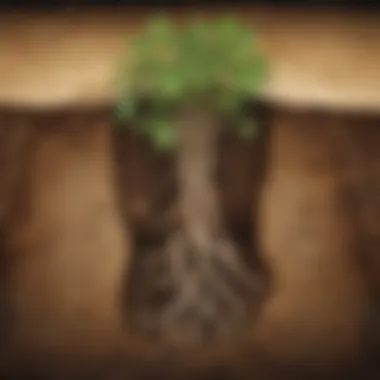Embark on a Fascinating Bean Growth Project for Young Science Enthusiasts


Science Fun Facts
Did you know that beans are not only a common food source but also a fascinating subject for science projects? Their growth stages offer an exciting opportunity for young minds to delve into the wonders of plant development. As we explore the journey of bean growth, prepare to be amazed by the intricate processes that unfold within a simple seed.
Discover the Wonders of Science
In the realm of scientific exploration, observing bean growth goes beyond watching a plant sprout from the soil. It introduces children to fundamental scientific concepts such as germination, photosynthesis, and the importance of water and sunlight for plant growth. Through engaging educational videos and interactive tools, young scientists can visualize these processes, sparking their curiosity for the natural world.
Science Quiz Time
Are you ready to test your knowledge on bean growth? Interactive quizzes will challenge your understanding of the stages a bean plant goes through as it matures. Multiple-choice questions will assess your grasp of critical scientific concepts, turning learning into an exciting game of knowledge acquisition.
Science Experiment Showcase
Get your hands dirty with fun and engaging experiments that bring bean growth to life. Follow step-by-step instructions meticulously crafted to ensure a successful and educational experience. From preparing the materials needed to understanding safety tips, every aspect of conducting the experiment will be covered to guarantee a seamless learning journey.
Introduction to Bean Growth
In the fascinating world of plant science, bean growth stands out as an exemplary subject for exploration. Understanding the intricacies of bean growth not only provides valuable insights into botany but also offers a hands-on learning experience. Through this article, young science enthusiasts will delve into the fundamental principles governing the growth of beans, setting the stage for a compelling journey of discovery.
Understanding the Science Behind Bean Growth
The Anatomy of a Bean Seed


Exploring the anatomy of a bean seed unravels the fundamental structure that dictates the bean's growth trajectory. The outer seed coat protects the delicate embryo within, ensuring its safety and optimal conditions for germination. This protective coating serves as a shield against external stressors, safeguarding the vital genetic material enclosed within. Analyzing the intricate layers of the seed coat reveals the meticulous design that nature has crafted to nurture the nascent plant. Understanding this protective shield is crucial for appreciating the resilience and adaptability of bean seeds in various environments.
Germination Process
The germination process marks the beginning of a bean seed's transformation into a thriving plant. As the seed awakens from dormancy, internal processes trigger rapid cell division and metabolic activity, propelling the embryo to burst through its shell and unfurl into the soil. This pivotal stage demands meticulous care and optimal conditions to ensure successful germination. Examining the nuances of this process sheds light on the intricate mechanisms that dictate plant development from a tiny seed to a robust seedling.
Factors Affecting Growth
Several factors influence the growth of beans, orchestrating a delicate balance that defines their development. From the availability of sunlight to the richness of the soil, each variable plays a crucial role in determining the plant's vitality. Understanding how factors like water, temperature, and nutrients impact bean growth is essential for cultivating a thriving garden. By dissecting the interplay of these elements, young scientists gain a comprehensive understanding of the interconnected processes governing plant growth.
Setting Up the Experiment
Embarking on the bean growth experiment necessitates meticulous planning and execution to ensure optimal conditions for observation. From procuring the necessary materials to preparing a conducive growing environment, each step sets the foundation for a successful scientific endeavor.
Materials Needed
Gathering the essential materials for the experiment is a critical first step towards unraveling the mysteries of bean growth. From seeds to soil, containers, and measuring tools, each component plays a pivotal role in facilitating the observational process. Ensuring the quality and quantity of materials is paramount for obtaining accurate results and fostering an enriching learning experience. By meticulously assembling the required items, young scientists set the stage for a productive exploration of plant growth.
Preparing the Growing Environment
Creating an optimal growing environment is key to nurturing healthy bean plants through their developmental stages. From selecting the right container to providing adequate sunlight and water, every detail contributes to the success of the experiment. Balancing factors like humidity and temperature creates a conducive atmosphere for plant growth, enabling young scientists to witness the magic of nature unfolding before their eyes.
Planting the Beans


The act of planting beans marks the commencement of the experiment and symbolizes a leap of faith into the realm of botanical exploration. From sowing the seeds at the optimal depth to ensuring proper spacing, each action sets the stage for germination and growth. Observing the initial stages of planting offers valuable insights into seed behavior and soil interactions, laying the foundation for a deeper understanding of plant development. Through careful planting and diligent observation, young scientists embark on a journey of discovery that promises exciting insights into the world of plant biology.
Observing Growth Progress
Monitoring Daily Growth
Observing Growth Progress is a critical aspect of this article as it allows young learners to track the development of beans meticulously. By monitoring daily growth, children can witness the visible changes in the beans, fostering a deeper understanding of plant life cycles and scientific observation. This process enhances their observational skills and encourages a hands-on approach to learning.
Recording Observations
When it comes to Recording Observations, it plays a pivotal role in capturing the minute details of growth progression. Children can note down the changes in size, color, and structure of the beans over time. This method not only helps in organizing data but also cultivates a habit of precision in scientific record-keeping. The systematic approach of Recording Observations ensures that no detail goes unnoticed, contributing to a comprehensive study of bean growth.
Measuring Growth Parameters
Measuring Growth Parameters involves quantifying the growth of beans based on specific metrics like height, leaf count, and root development. This quantitative approach provides a numerical perspective on bean growth, enabling children to analyze the rate of development accurately. By measuring growth parameters, young scientists can establish trends and patterns in growth, enhancing their analytical skills and reinforcing the principle of measurement in scientific experiments.
Documenting Changes
Documenting Changes is essential for capturing the overall transformation process of beans effectively. This method involves photographing the beans at different stages, creating a visual timeline of growth. Documenting Changes not only serves as a reference point for comparisons but also offers a vivid representation of the growth journey. Through documenting changes, children can retrospectively analyze the evolution of beans, fostering a holistic understanding of plant development.
Understanding Growth Factors
Understanding Growth Factors sheds light on the external elements that influence bean growth. By delving into the Effects of Light, children can comprehend the significance of sunlight in photosynthesis and its impact on plant growth. The Watering Regimen section emphasizes the importance of adequate hydration for plants and how water availability affects bean development. Nutrient Requirements highlight the essential minerals and elements necessary for healthy bean growth, underscoring the role of nutrients in plant nutrition and sustainability.


Analyzing Results and Conclusion
Interpreting Data
Growth Trends
: As preschool discovered, Gwowth Trends in our project refer to the gradual development patterns displayed by the bean plants over time. Observing growth trends allows young scientists to track the progression of their experiment and analyze how external factors influence the plants' development. One significant characteristic of growth trends is their consistency in reflecting the impact of environmental conditions on plant growth. This aspect is particularly valuable for our study as it enables participants to investigate the direct correlation between, for example, light exposure and the rate of growth in bean plants. Despite occasional fluctuations, growth trends provide a reliable indicator of the experiment's progression and facilitate comprehensive data interpretation.
Anomalies in Growth
: Encounting unexpected quirks is an essential part of any scientific investigation. Anomalies in growth refer to deviations from the anticipated development pattern of bean plants during the experiment. These anomalies, while seemingly disruptive, offer valuable insights into the resilience and adaptability of the plants to varying conditions. By highlighting anomalies, budding scientists can enhance their critical thinking skills and explore the underlying reasons behind unexpected growth behavior. Understanding anomalies promotes a more in-depth analysis of the experiment's dynamics, prompting participants to consider factors beyond the standard growth parameters.
Comparative Analysis
Diving deep into a comparative analysis involves contrasting the growth data of different bean plants subjected to varying experimental conditions. This analytical approach allows young researchers to identify the effects of specific variables on plant growth and compare the outcomes across different setups. A key characteristic of comparative analysis is its ability to illuminate the influence of environmental factors such as light, water, and nutrients on plant development. By drawing comparisons between growth patterns, participants can discern the optimal conditions for promoting robust bean growth and make informed conclusions based on empirical evidence.
Drawing Conclusions
: Wrapping up our exploration, drawing conclusions involves synthesizing the findings and insights gained from observing bean plant growth. This final step encapsulates the key learnings derived from the experiment, providing participants with a comprehensive understanding of the project outcomes. By reflecting on the growth trends, anomalies encountered, and comparative data analysis, young scientists can extract valuable lessons about plant biology and the impact of environmental variables. Through drawing conclusions, participants are encouraged to form hypotheses, make predictions for future experiments, and contemplate the broader implications of their research.
Key Learnings
Unpacking the essential teachings from our bean growth project, key learnings encompass the fundamental discoveries made during the experiment. By identifying patterns, correlations, and causal relationships in the data, participants gain valuable insights into the intricate world of plant development. One key characteristic of key learnings is their applicability beyond the scope of the current project, guiding young scientists in formulating informed hypotheses for future botanical studies.
Future Considerations
Exploring the realm of possibilities, future considerations prompt participants to contemplate the potential trajectories of their research and identify areas for improvement or expansion. By recognizing the limitations of the current experiment and envisioning future directions, young scientists can refine their methodologies, set new research goals, and enhance their scientific inquiry skills. A unique feature of future considerations is their role in fostering a forward-thinking mindset among participants, encouraging them to embrace continuous learning and innovation in their scientific pursuits.
Impact of Findings
Evaluating the significance of our research outcomes, the impact of findings reflects the practical implications of the bean growth project. This aspect highlights how the experiment's results contribute to our understanding of plant biology, environmental science, and experimental methodology. An essential characteristic of the impact of findings is its role in inspiring curiosity and enthusiasm for scientific exploration among participants. By recognizing the value of their research contributions, young scientists are motivated to further engage with investigative projects, pursue deeper inquiries, and make meaningful contributions to the field of science.







